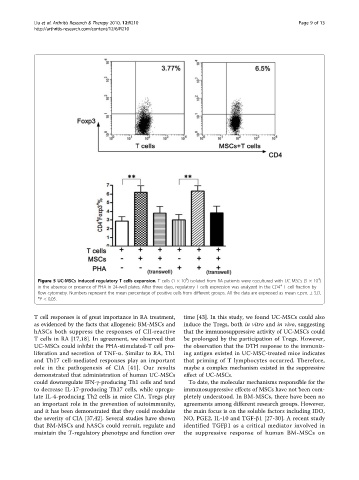Page 100 - Power of Stem Cells- arthritis and regeneration
P. 100
Liu et al. Arthritis Research & Therapy 2010, 12:R210 Page 9 of 13
http://arthritis-research.com/content/12/6/R210
6
4
Figure 5 UC-MSCs induced regulatory T cells expansion. T cells (1 × 10 ) isolated from RA patients were cocultured with UC-MSCs (5 × 10 )
+
in the absence or presence of PHA in 24-well plates. After three days, regulatory T cells expression was analyzed in the CD4 T cell fraction by
flow cytometry. Numbers represent the mean percentage of positive cells from different groups. All the data are expressed as mean c.p.m. ± S.D,
*P < 0.05.
T cell responses is of great importance in RA treatment, time [43]. In this study, we found UC-MSCs could also
as evidenced by the facts that allogeneic BM-MSCs and induce the Tregs, both in vitro and in vivo, suggesting
hASCs both suppress the responses of CII-reactive that the immunosuppressive activity of UC-MSCs could
T cells in RA [17,18]. In agreement, we observed that be prolonged by the participation of Tregs. However,
UC-MSCs could inhibit the PHA-stimulated-T cell pro- the observation that the DTH response to the immuniz-
liferation and secretion of TNF-a. Similar to RA, Th1 ing antigen existed in UC-MSC-treated mice indicates
and Th17 cell-mediated responses play an important that priming of T lymphocytes occurred. Therefore,
role in the pathogenesis of CIA [41]. Our results maybe a complex mechanism existed in the suppressive
demonstrated that administration of human UC-MSCs effect of UC-MSCs.
could downregulate IFN-g-producing Th1 cells and tend To date, the molecular mechanisms responsible for the
to decrease IL-17-producing Th17 cells, while upregu- immunosuppressive effects of MSCs have not been com-
late IL-4-producing Th2 cells in mice CIA. Tregs play pletely understood. In BM-MSCs, there have been no
an important role in the prevention of autoimmunity, agreements among different research groups. However,
and it has been demonstrated that they could modulate the main focus is on the soluble factors including IDO,
the severity of CIA [37,42]. Several studies have shown NO, PGE2, IL-10 and TGF-b1 [27-30]. A recent study
that BM-MSCs and hASCs could recruit, regulate and identified TGFb1 as a critical mediator involved in
maintain the T-regulatory phenotype and function over the suppressive response of human BM-MSCs on

